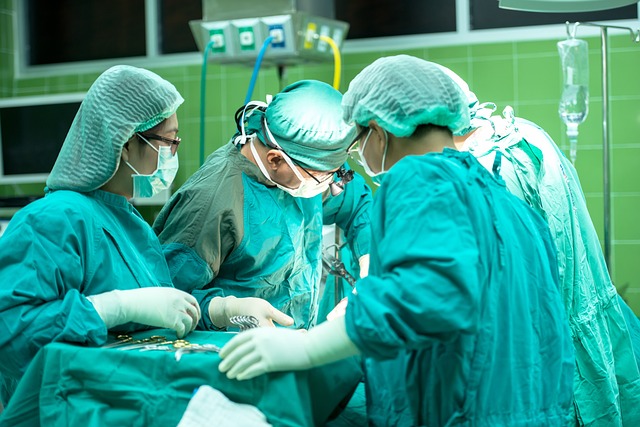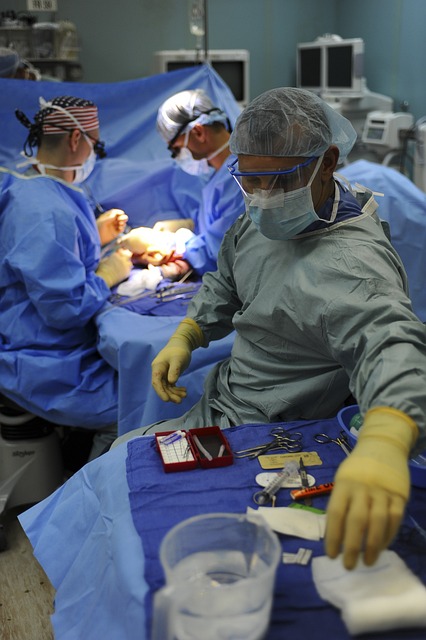Tissue repair is a multi-stage process crucial for optimal post-operative recovery, involving inflammation, cell proliferation, and remodeling. Traditional post-op care, while aiming to support patients, often falls short in accelerating regeneration and improving outcomes due to its focus on symptomatic relief. Regenerative therapies, leveraging stem cells, growth factors, and biotechnologies, offer a paradigm shift by harnessing the body's natural healing mechanisms. These advanced treatments, including cell therapy and tissue engineering, accelerate recovery, minimize scarring, and reduce the need for further surgeries, revolutionizing patient outcomes in post-operative care. Integrating these therapies into post-op plans shows promise in enhancing tissue repair and optimizing patient satisfaction.
Regenerative therapies are revolutionizing post-operative care, offering new hope for faster and more effective tissue repair. This article delves into the fascinating world of tissue regeneration, exploring how the body’s natural healing process can be enhanced through cutting-edge treatments. We’ll discuss limitations in traditional post-operative care, introduce regenerative therapies, review various types, and examine their integration into healing plans. By understanding these innovative approaches, healthcare professionals can navigate a new era of improved patient outcomes.
- Understanding Tissue Repair: The Body's Natural Process
- Limitations of Traditional Post-Operative Care
- Introduction to Regenerative Therapies
- Types of Regenerative Therapies for Enhanced Healing
- Integrating Regenerative Therapies in Post-Operative Care Plans
Understanding Tissue Repair: The Body's Natural Process

Tissue repair is a complex, multifaceted process that occurs naturally within the human body. It’s a delicate dance involving various specialized cells, growth factors, and signaling molecules working together to heal and regenerate damaged tissue. This intricate mechanism kicks into gear immediately after an injury or surgical procedure, like in post-operative care.
The body’s initial response is inflammation, where immune cells rush to the site to contain damage and initiate healing. This is followed by a proliferation phase where new cells are generated and tissue regeneration begins. Eventually, remodeling takes place as the newly formed tissue strengthens and integrates into the surrounding area. Understanding these stages is crucial when considering regenerative therapies, which aim to amplify and accelerate the body’s natural ability to repair itself.
Limitations of Traditional Post-Operative Care

Traditional post-operative care often involves a range of measures aimed at supporting patients during their recovery period. However, despite these efforts, there are several limitations that can hinder optimal tissue repair. One significant challenge is the emphasis on symptomatic relief rather than addressing the fundamental causes of tissue damage. While pain management and infection control are crucial aspects, they may not stimulate the body’s inherent regenerative capabilities.
Moreover, conventional post-op care often lacks targeted interventions to accelerate tissue regeneration. This can result in prolonged recovery times, increased risk of complications, and suboptimal functional outcomes. The complex interplay between various cell types, growth factors, and the microenvironment is not fully tapped into, leading to less than ideal healing. Therefore, exploring regenerative therapies that can complement traditional post-operative care is essential to enhance tissue repair and improve patient outcomes.
Introduction to Regenerative Therapies

Regenerative therapies represent a groundbreaking advancement in medicine, offering promising solutions for enhancing tissue repair and regeneration. These cutting-edge treatments go beyond traditional healing methods by stimulating the body’s inherent ability to heal itself. By harnessing the power of stem cells, growth factors, and advanced biotechnologies, regenerative therapies aim to restore damaged tissues and organs to their optimal function.
In the context of post-operative care, regenerative therapies play a pivotal role in accelerating recovery and improving patient outcomes. After surgery, traditional methods often focus on managing pain and preventing infection. However, regenerative approaches go a step further by actively promoting tissue regeneration, reducing scar formation, and potentially minimizing the need for invasive procedures or repeated surgeries. This innovative field holds immense potential to revolutionize post-operative care, ensuring faster healing, enhanced functional recovery, and improved overall patient satisfaction.
Types of Regenerative Therapies for Enhanced Healing

Regenerative therapies offer a promising approach to enhancing tissue repair, especially in the context of post-operative care. These advanced treatments aim to stimulate the body’s natural healing processes by encouraging the growth and regeneration of damaged or diseased tissues. One prominent type is cell therapy, which involves the transplantation of healthy cells to replace or repair injured tissues. This can include stem cell therapies, where versatile stem cells are used to differentiate into specific cell types needed for healing.
Another key player in regenerative medicine is tissue engineering, a field combining biology and engineering to design functional tissues and organs. This approach often uses scaffolds, biomaterials, and growth factors to create an environment that supports the regeneration of tissues. Moreover, advancements in 3D printing technology have enabled the creation of custom-made scaffolds, allowing for more precise and effective tissue reconstruction, particularly in complex cases requiring post-operative care.
Integrating Regenerative Therapies in Post-Operative Care Plans

Integrating regenerative therapies into post-operative care plans offers a promising approach to enhancing tissue repair and optimizing patient outcomes. These cutting-edge treatments, such as stem cell therapy or tissue engineering, can be strategically incorporated into the recovery process following surgery. By doing so, healthcare professionals aim to stimulate the body’s natural healing mechanisms, promoting faster regeneration of damaged tissues.
Post-operative care is a critical phase where regenerative therapies can have a significant impact. During this period, patients often face challenges in wound healing and tissue restoration. Integrating these advanced treatments can help accelerate recovery, reduce scar formation, and potentially minimize the need for additional surgical interventions. Such an approach not only improves patient satisfaction but also contributes to more efficient healthcare management.
Regenerative therapies offer a promising path forward in enhancing tissue repair, addressing the limitations of traditional post-operative care. By harnessing the body’s inherent regenerative capabilities, these innovative treatments have the potential to revolutionize healing processes, leading to improved patient outcomes and faster recovery times in post-operative settings. Integrating regenerative therapies into comprehensive post-operative care plans is a strategic step towards optimizing patient care and ensuring better long-term health outcomes.
